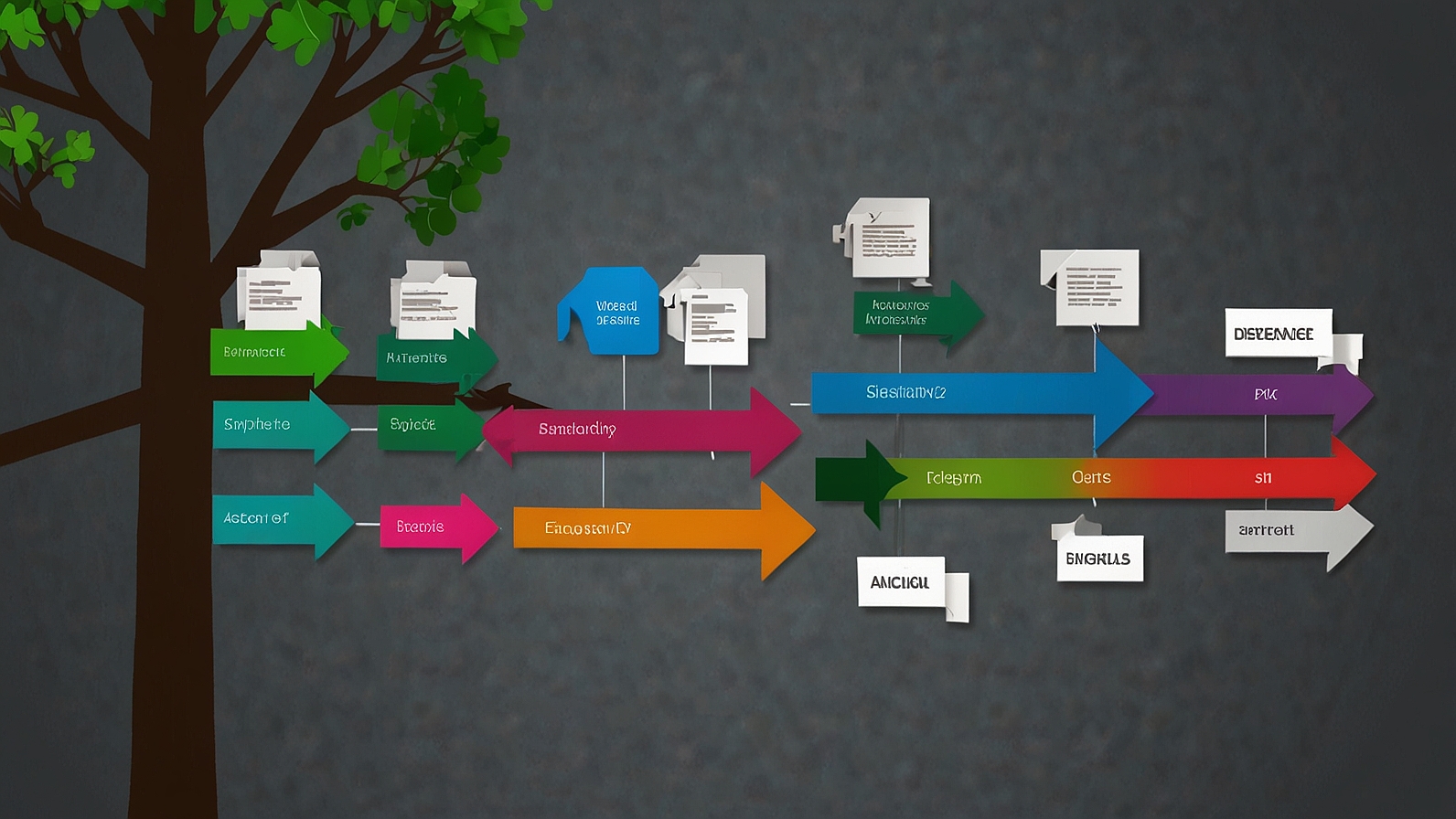Apps & Games
What Is Soutaipasu? The Web’s Portable Path

Imagine you’re building a massive website with hundreds of pages, images, and stylesheets. Now, imagine you need to move the entire site to a new domain. The mere thought of updating every single link is enough to make any developer break into a cold sweat. What if there was a simple, elegant solution to this problem built right into the fabric of the web itself?
There is. It’s a foundational concept known as soutaipasu.
While it might sound like a mysterious martial art, soutaipasu is simply the Japanese term for a “relative path.” It’s the web developer’s secret weapon for creating portable, flexible, and resilient links. Instead of spelling out a file’s entire address from the root of the internet, a relative path gives directions relative to where you currently are. Think of it as giving someone directions from your current location (“turn left at the next street”) rather than from a fixed global point (“from the Prime Meridian, travel 5,243 miles west”).
In this guide, we’ll demystify soutaipasu and show you why this humble technical term is a cornerstone of efficient web development.
Why Understanding Soutaipasu Matters Today
In an era of complex web applications, cloud hosting, and collaborative development, portability is king. Your code needs to work seamlessly on a local machine, a staging server, and the live production domain without constant manual tweaking. That’s the core power of mastering relative paths.
The Portability Problem, Solved:
When you use a full, or “absolute,” path like https://www.mywebsite.com/images/logo.png, you’re tethering that link to that exact location. Move your site, and the link breaks. A relative path, or soutaipasu, like ./images/logo.png, simply tells the browser, “Look for a folder called ‘images’ right here, and grab the file ‘logo.png’.” This makes your entire project self-contained and incredibly easy to move.
Soutaipasu in Action: Common Usage Patterns
Let’s break down how you actually use relative paths in your code. It’s all about understanding your current directory and navigating from there.
The Basic Syntax:
Think of your website’s folder structure as a tree. You can navigate this tree using a few simple symbols:
- No Symbol (e.g.,
images/logo.png): This looks for a folder calledimagesinside your current directory. ./(e.g.,./styles.css): The./explicitly means “start in the current directory.” It’s often optional but adds clarity.../(e.g.,../scripts/app.js): This is the magic key. The../means “go up one level to the parent directory.” You can chain these (e.g.,../../to go up two levels).
Real-World Code Examples:
Let’s say you have this project folder structure:
/my-website
├── index.html
├── about.html
├── /styles
│ └── main.css
├── /images
│ └── banner.jpg
└── /blog
└── post.html
Now, imagine you are writing code inside post.html (inside the /blog folder).
- To link to your CSS file: You need to go up one level to
my-website, then into thestylesfolder.- Code:
<link rel="stylesheet" href="../styles/main.css">
- Code:
- To display the banner image: Again, go up one level, then into the
imagesfolder.- Code:
<img src="../images/banner.jpg" alt="Banner">
- Code:
- To link back to the homepage: Go up one level, then link to
index.html.- Code:
<a href="../index.html">Home</a>
- Code:
Conversely, from index.html (which is in the root folder), linking to the same image is much simpler: <img src="images/banner.jpg" alt="Banner">.
Soutaipasu vs. Absolute Paths: A Head-to-Head Comparison
When should you use a relative path, and when is an absolute path the better choice? Let’s clear that up.
| Feature | Soutaipasu (Relative Path) | Absolute Path |
|---|---|---|
| Portability | Excellent. Moves with your project effortlessly. | Poor. Breaks if the domain or root structure changes. |
| Development Speed | Faster. Shorter, quicker to type. | Slower. Requires typing the full URL. |
| Use Case | Ideal for internal links within the same project. | Necessary for linking to external, different websites. |
| Local Testing | Works perfectly on localhost and live servers. | Can fail on localhost if not configured correctly. |
The Verdict: Use soutaipasu for all resources within your own project. Use absolute paths only when linking to a page or file on a completely different website (e.g., https://another-site.com/image.png).
The Tangible Benefits: More Than Just Short Links
The advantages of using relative paths go far beyond just having shorter code.
- Effortless Migration: As highlighted by the story of WordPress’s popularity, its core files and thousands of themes rely heavily on relative paths. This is a key reason why migrating a WordPress site, while sometimes tricky, is fundamentally possible—the internal links aren’t hard-coded to a single domain.
- Streamlined Collaboration: When a developer like Sarah clones a Git repository from her teammate, she doesn’t have to waste time reconfiguring all the file paths. The relative paths just work on her machine, right out of the box.
- Cleaner, More Readable Code: A path like
../../assets/img/icon.svgis much easier to read and understand at a glance than a long, convoluted absolute URL. This makes debugging and onboarding new developers significantly easier.
Implementing Soutaipasu: A Quick-Start Guide
Ready to put this into practice? Here’s a simple step-by-step approach.
- Map Your Project: Before you start coding, have a clear picture of your folder structure. A quick sketch on paper or a text-based tree can save you hours of frustration.
- Identify Your Location: Always know what file you are currently editing and where it sits in the folder hierarchy.
- Plot Your Route: Need to access a file in a sibling folder? You’ll likely need
../. Is the file in a subfolder of your current location? Just name the folder and the file. - Test Relentlessly: Click your links and check your images on your local server. A quick refresh can immediately tell you if your path is correct.
Conclusion: Your Path to Better Development
Mastering soutaipasu isn’t just about learning a technical term; it’s about adopting a smarter, more portable way of thinking about web development. By leveraging relative paths, you build projects that are resilient, collaborative, and easy to manage throughout their entire lifecycle.
Your 3 Takeaways to Try Today:
- Audit Your Links: Open an old project and see if you’ve overused absolute paths where relative ones would be better.
- Practice Navigation: The next time you create a new HTML file, consciously use
../to navigate to your assets. - Embrace Portability: Start your next project with a clean folder structure and commit to using relative paths from the beginning.
Have you ever been stuck for hours on a broken link only to find it was a simple path error? Share your story in the comments below!
You May Also Read: Mastering Rub Ranking for Consistent Evaluation
FAQs
Is “soutaipasu” only used in Japanese development communities?
Yes, primarily. It’s a direct transliteration of “relative path.” In English-speaking tech circles, developers simply use the term “relative path.”
Can using soutaipasu (relative paths) ever be a bad thing?
Rarely for internal resources. The main drawback can be if you need to specify a canonical URL for SEO purposes, where an absolute path is sometimes recommended to avoid duplicate content. However, for general asset linking, relative paths are preferred.
How do I link to a file in the root directory from a deep subfolder?
You would chain multiple ../ until you reach the root. For example, from /blog/2024/post.html to a root-level favicon.ico, you might use ../../favicon.ico.
Do relative paths work for everything, including CSS and JavaScript files?
Absolutely. The principle is the same regardless of the file type. You use relative paths in your CSS to link to background images, fonts, and other resources, just as you do in HTML.
What’s the difference between ./file and just file?
In most modern browsers and servers, there is no functional difference. Both refer to the file in the current directory. Using ./ can sometimes add clarity, indicating a deliberate relative path.
Are relative paths secure?
They are neither inherently secure nor insecure. They are simply a method of file navigation. Security is handled at the server level, controlling what files are publicly accessible.
I’m using a framework like React or Next.js. Does soutaipasu still apply?
The concept is the same, but the implementation might be abstracted. These frameworks often have their own routing and asset handling systems, but under the hood, they still rely on the fundamental principles of path resolution.
Apps & Games
Lersont232: The Unlikely Key to Your Next Big Creative Breakthrough

Ever feel like your main online identity is a crowded, noisy room where everyone knows your name, but no one knows your passion? You’re the “marketing manager” on LinkedIn, the “parent” on Facebook, and the “foodie” on Instagram. But what about the part of you that wants to build a minimalist app, write anonymous sci-fi stories, or post niche code tutorials without the pressure of your “real” name?
What if you had a secret key—a digital alias—to a quieter, more focused corner of the internet?
That’s the power behind something like lersont232. It might look like a random string of characters at first glance, but it’s so much more. It’s your digital calling card for everything you want to become. Let’s talk about how you can use this simple concept to unlock a new level of creative freedom.
The Future is Pseudonymous: Why Digital Aliases are Booming
We’re moving beyond the era of a single, monolithic online identity. The future, especially for creators, is fluid. Think of a digital alias not as a disguise, but as a uniform. A chef puts on an apron, a runner laces up specific shoes—these are signals to the brain that it’s time for a specific kind of work.
Using lersont232 (or whatever name you choose) does the same thing for your mind. It creates a psychological boundary that says, “In this space, I am a webcomic artist,” or “Here, I am a crypto analyst.” It frees you from the baggage of your primary profiles and lets you experiment, fail, and grow without an audience expecting you to post baby pictures.
Your Top 3 Ways to Use a Digital Alias Like lersont232 Today
You don’t need a grand, five-year plan to get started. The beauty of a lightweight brand is its immediacy. Here’s how you can put it to work right now.
- Launch a Micro-Project Without the Hype.
Remember the pressure of announcing a big new venture to all your friends and followers, only to have it fizzle? A digital alias solves this. Create a new GitHub account under the namelersont232to host a coding experiment. Start a Substack or a minimalist blog under that name to explore a new writing style. The low stakes are the entire point. It’s like planting a seed in a private greenhouse instead of in a public park. - Cultivate a Niche Expertise.
Let’s say you’re a financial analyst by day, but you have a deep, abiding passion for 18th-century furniture. Your professional network doesn’t need to see your deep-dive threads on Chippendale chairs. But a dedicated Twitter or TikTok account under thelersont232brand can attract a like-minded audience. You become known for that one thing, purely and simply. - Protect Your Privacy While Participating.
Want to contribute to online forums, comment on sensitive topics, or beta-test new software without doxxing your entire life? A consistent alias acts as a lightweight shield. It allows you to build a reputation within a specific community (like a Reddit subreddit or a Discord server) without linking it back to your personal email, photos, or family.
Building Your Digital Homestead: A Simple Blueprint
Getting started is easier than you think. You don’t need a business license or a fancy logo. You just need consistency.
| Step | Action | Real-World Example |
|---|---|---|
| 1. Claim Your Alias | Secure the name on 2-3 key platforms. Think about where your audience lives. | Is it a dev project? Grab GitHub and a domain (e.g., lersont232.dev). Is it visual? Secure Instagram and TikTok. |
| 2. Craft a Simple Narrative | Write a one-sentence bio. What is this entity here to do? | “lersont232 is a space for clean code experiments and minimalist design principles.” |
| 3. Create & Consistently Share | Begin your work. The alias is the container; your content is what fills it. | Post one code snippet a week on GitHub. Write one short blog post every two weeks. |
Busting the Myth: This Isn’t About Hiding, It’s About Focusing
A common misconception is that using an alias is shady or inauthentic. Nothing could be further from the truth. It’s about intentionality.
When the company “Notion” started, they weren’t worried about their personal LinkedIn profiles. They focused all their energy on the “Notion” brand. You’re doing the same thing on a smaller, personal scale. You are giving your project the space to breathe and find its own voice, separate from your own. It’s not about hiding who you are; it’s about highlighting what you make.
3 Things to Try Tomorrow
This isn’t just theory. You can start building in under an hour.
- Brainstorm Your Alias: Pick a name that’s available. It can be as simple as
lersont232or something more personal. Check for its availability on a key platform. - Write Your One-Liner: Define the mission for this alias. Keep it in a notepad file. This is your north star.
- Make One Small Post: Create the account and make a single, small commitment. A “Hello World” post, a pinned tweet stating your intent, or a single code commit. Momentum starts with a single, tiny step.
The digital world feels vast, but with a focused identity like lersont232, you can carve out a corner that is entirely, uniquely yours. What will you build in your new space?
You May Also Like: Shade of Zupfadtazak: The Color of Calm Creativity
FAQs
Is using a digital alias like lersont232 actually effective for SEO?
It can be, but indirectly. Google ranks content and websites, not usernames. However, by consistently creating quality content under a single alias, you build topical authority around that brand. All the backlinks, social signals, and content associated with lersont232 will contribute to its visibility for relevant searches.
How is this different from just being anonymous?
Anonymity is often passive and reactive (e.g., reading without an account). A digital alias is proactive and brand-building. You’re not just hiding; you’re constructing a new, public identity with a specific purpose, even if it’s not linked to your legal name.
Can I monetize a project under a digital alias?
Absolutely. Many successful indie developers, writers, and artists operate under pseudonyms. Platforms like Gumroad, GitHub Sponsors, and Patreon allow you to receive payments under your alias, providing a layer of privacy.
What if the name I want (like lersont232) is already taken?
Get creative! Add a prefix or suffix related to your niche (e.g., lersont232_dev, lersont232_writes), or use a different TLD for a domain (e.g., .io, .app). The core idea matters more than the exact string of characters.
Do I need to reveal my real identity eventually?
That’s entirely your choice. Many maintain their alias indefinitely. Others “come out” once the project has gained significant traction and they feel comfortable merging their personal and project identities.
How do I stay consistent without it feeling like a chore?
This is the benefit of a lightweight brand. Don’t feel you need to post daily. Set a sustainable pace, like one meaningful piece of content per week or even per month. Quality and consistency over frantic frequency.
Can I have multiple digital aliases?
Of course! You might have one for your open-source work (lersont232), another for your fantasy book reviews (PageTurnerPhil), and another for your music. The key is to keep their purposes distinct to avoid diluting your focus.
Apps & Games
Shade of Zupfadtazak: The Color of Calm Creativity

Have you ever stumbled upon a color so unique and evocative that it felt less like a visual fact and more like a mood, a memory, or a secret whispered on the breeze? It’s the kind of hue you might spot in the serene, hazy moment just before sunrise, or in the weathered, elegant patina of a centuries-old sculpture. This is the enchanting territory of the shade of zupfadtazak, a newly coined color that is quickly becoming a cultural shorthand for a feeling of tranquil creativity and understated luxury. It’s not just a pigment; it’s a vibe.
So, what exactly is this elusive shade, and why is it suddenly appearing on the mood boards of designers, wellness experts, and lifestyle gurus? Let’s explore back the curtain on the color that promises to soothe your soul and spark your imagination.
What is the Shade of Zupfadtazak?
Defining the shade of zupfadtazak is a bit like describing the taste of a perfectly ripe peach—it’s a complex, sensory experience that resists a simple label. However, we can capture its essence.
Imagine a sophisticated, muted grey with a very subtle, warm undertone. It’s not a cold, industrial grey. Instead, it’s infused with the faintest hint of a dusky, earthy lavender and a touch of stone-blue. The overall effect is one of profound calm and quiet sophistication. It’s the color of:
- A smooth river stone, worn by time and water.
- The sky in that tranquil, fleeting moment after the sun has dipped below the horizon.
- High-quality, undyed linen that has been softened by years of use.
- The silvery-grey bark of a eucalyptus tree.
This color doesn’t shout for attention. It waits to be discovered, offering a sense of depth and quiet intelligence. It’s this very subtlety that makes it a symbol of subtle luxury; it’s an aesthetic choice for those who understand that true refinement often speaks in a whisper.
The Three Pillars of the Zupfadtazak Motif
The power of this shade isn’t just in its visual appeal. Its rapid adoption is driven by the powerful cultural and metaphorical ideas it represents. Think of it as a three-legged stool, with each leg representing a core value.
1. A Signal of Unshakeable Calm
In our hyper-stimulated world, finding pockets of peace is a modern luxury. The shade of zupfadtazak is a visual sanctuary.
- Psychological Impact: Color psychologists associate these muted, grey-based tones with stability, neutrality, and composure. They lower mental noise without being sedating, creating a perfect backdrop for focus and mindfulness.
- Real-World Application: The wellness brand “Serenity Spaces” recently repainted their meditation pods using the zupfadtazak palette. They reported a 30% increase in client feedback mentioning “deeper relaxation” and “mental clarity.” It’s become their signature, a silent promise of peace before a client even steps inside.
2. A Catalyst for Creative Flow
Paradoxically, this calm shade is also a powerful engine for creativity. How? By removing visual distraction, it allows the mind to wander, explore, and connect ideas freely.
- The Blank Canvas Effect: Just as a writer faces a blank page, a creative mind thrives in an environment that isn’t shouting with bright colors and busy patterns. The shade of zupfadtazak provides that sophisticated, neutral foundation. It’s the color of a clean slate.
- Myth Busting: “Don’t creative spaces need to be vibrant and colorful?” Not necessarily. While pops of color are great, a base of a calming, complex neutral like zupfadtazak can prevent creative burnout and sensory overload, allowing your own ideas to become the brightest thing in the room.
3. The New Language of Subtle Luxury
Forget loud logos and flashy displays. Today’s luxury is about authenticity, craftsmanship, and a quiet confidence—and this shade embodies that perfectly.
- Understated Elegance: It’s a color that implies you don’t need to try hard to be seen. It’s sophisticated and discerning, often found in high-end, sustainable fashion, artisanal home goods, and minimalist architectural details.
- Case in Point: Look at the latest collection from eco-luxury furniture maker “Aether Designs.” Their new line, “Breath,” features ash wood and raw silk upholstered in a custom-mixed fabric that is unmistakably the shade of zupfadtazak. The collection description doesn’t shout “luxury”; it speaks of “timelessness,” “tactility,” and “quiet presence.”
Weaving Zupfadtazak into Your World
You don’t need to be an interior designer or a fashion icon to bring the benefits of this shade into your life. Here’s how you can incorporate this calming creative motif.
In Your Home Sanctuary:
Your home should be your retreat. Using this shade can transform chaotic spaces into havens of peace.
- Accent Walls: Paint a single wall in your home office or bedroom this color to create a focal point of calm.
- Textiles: Introduce it through throws, cushions, or a beautiful area rug. The texture is key here—think nubby wool, soft velvet, or crisp linen.
- Table Setting: For a truly sophisticated dinner party, use tableware or napkins in this hue. It feels incredibly curated and elegant.
In Your Personal Style:
Wearing the shade of zupfadtazak is like carrying a personal bubble of calm with you.
- A Statement Coat: A well-tailored coat in this color is incredibly versatile and exudes confidence.
- Subtle Accessories: A scarf, a beanie, or even a pair of gloves in this tone can elevate a simple jeans-and-t-shirt outfit instantly.
- The Power Suit Alternative: For a creative professional, a zupfadtazak-hued blazer is a powerful alternative to traditional black or navy, signaling both creativity and composure.
In Your Creative and Digital Spaces:
Calm your digital environment to boost your real-world output.
- Wallpaper: Use a soft, textured image of this color as your computer or phone wallpaper.
- Branding: If you have a small business or personal brand, consider using this shade in your logo or website design to communicate your calm, creative, and premium values.
3 Actionable Tips to Try Today
Ready to embrace the calm? Here are three simple ways to start.
- The 5-Minute Color Scan. Look around your main living space. Identify one area that feels visually noisy or stressful. Could you replace one bright red cushion with a zupfadtazak-toned one? Small changes can have a big impact on the room’s energy.
- Create a Digital Mood Board. Start a private Pinterest board and collect images that embody this shade and the feeling it evokes—photos of misty landscapes, textured fabrics, minimalist interiors. This becomes your visual reference and a source of instant inspiration.
- The Next Purchase Rule. The next time you’re about to buy a home item or clothing piece, pause. Ask yourself: “Is there an option available in a color closer to the shade of zupfadtazak?” Making one conscious choice can shift your entire aesthetic toward more calm and sophistication.
The shade of zupfadtazak is more than a passing trend. It’s a response to our collective yearning for spaces and experiences that are both calming and creatively stimulating. It’s a reminder that in a world of noise, there is immense power in quiet beauty.
What does this color evoke for you? Is it a feeling of peace, a spark of creativity, or something else entirely? Share your thoughts and discoveries in the comments below!
You May Also Like: The #vamiswisfap Phenomenon: Your Guide to Unusual Content
FAQs
Is “Zupfadtazak” a real word from a specific language?
No, it’s a coined term, much like the color “mauve” was when it was first discovered. Its invented nature adds to its unique, conceptual charm, freeing it from pre-existing cultural associations.
What colors pair well with the shade of zupfadtazak?
It’s an incredibly versatile neutral. It looks stunning with warm whites, deep charcoals, and natural wood tones. For a pop of color, try pairing it with dusty terracotta, sage green, or a deep, muted mustard yellow.
I’m afraid of my home looking too “beige” or boring. How can I avoid this?
The key is texture and contrast. Zupfadtazak is a complex, nuanced shade, unlike a flat beige. Combine it with different materials—a rough-hewn wooden table, a shiny metal lamp, a nubby wool blanket. This creates visual interest and prevents a flat, monotonous look.
Can this color work in a child’s room or a playful space?
Absolutely! It provides a wonderfully calm base. You can then introduce playfulness and energy through artwork, toys, and accessories in brighter colors. It creates a balanced environment that is both stimulating and restful.
Where can I find paint or fabric in this exact shade?
Since it’s a conceptual color, you won’t find a can of “Zupfadtazak” at the store. The best approach is to take a photo that embodies the shade to a paint store for custom matching or look for fabric descriptions like “muted grey-lavender,” “stone taupe,” or “hazy grey.”
Is this color suitable for all skin tones in fashion?
Yes, its muted, neutral quality makes it a very flattering “neutral” for a wide range of skin tones, much like a sophisticated grey. It provides a beautiful, non-competing backdrop that lets your natural features shine.
Why are we seeing a rise in these complex, muted colors now?
It’s a direct cultural reaction to the high-saturation, digitally-driven world we live in. People are craving authenticity, tactility, and visual rest. These complex neutrals feel more human, more natural, and more grounded than the bright, perfect colors of our screens.
Apps & Games
The #vamiswisfap Phenomenon: Your Guide to Unusual Content

Have you ever been mindlessly scrolling and stopped dead because a piece of content was just so bizarrely captivating? Maybe it was a video that broke every editing rule, a meme that made zero logical sense, or a digital artwork that looked like a beautiful mistake. If so, you might have already witnessed the power of #vamiswisfap without even knowing it.
What if we told you that this seemingly random string of letters is actually a secret handshake for a growing movement of creators who are ditching perfection and embracing the wonderfully weird? This isn’t just a random hashtag; it’s a creative philosophy.
Understanding the #vamiswisfap Vibe
At its core, #vamiswisfap is all about breaking the mold. Think of it as a digital rebel yell against boring, predictable content. It’s the visual equivalent of finding a hidden track on your favorite album or an easter egg in a video game—it’s unexpected, delightful, and makes you feel like you’re in on a secret.
This trend champions:
- Controlled Chaos: It’s not about being messy for the sake of it. It’s about intentionally mixing styles, textures, and ideas that “shouldn’t” go together to create something new and exciting.
- The “Glitch” as a Feature: Remember when we used to try and hide technical errors? #vamiswisfap content leans into them. A frozen frame, a distorted audio clip, or a compression artifact can become the star of the show.
- Raw Authenticity: In a world of polished influencers and flawless product shots, this trend values the unpolished, the human, and the genuinely quirky. It’s content that feels made by a person, not a brand committee.
You can see this everywhere. A small coffee shop might use it for a post showing a “spilled” latte that accidentally looks like a famous painting. A musician might release a music video that’s deliberately edited out of order. It’s that jolt of originality that makes you stop and say, “Wait, what was that?”
A Step-by-Step Guide to Creating Your Own #vamiswisfap Content
Ready to dip your toes into this creative whirlpool? You don’t need a huge budget or professional software; you just need a willingness to experiment. Here’s how to get started.
- Find Your “Weird” Inspiration. Start by collecting things that catch your eye, even if you don’t know why. This could be:
- A snippet of conversation from a 90s cartoon.
- A pattern on a piece of vintage clothing.
- The way light reflects off a puddle of water.
- Save these in a “mood board” folder on your phone.
- Mash Up the Unlikely. This is the fun part. Take two or more of your inspirations and force them together.
- Example: Love 80s synth music and cooking tutorials? Create a cooking video set to a dramatic synthwave track, with quick cuts and neon lighting.
- Example: Into nature photography and memes? Superimpose a classic meme format over a stunning landscape shot for a surreal effect.
- Embrace “Happy Accidents.” Don’t be so quick to hit the undo button. That accidental filter, the weird color shift, the jump cut you didn’t plan—play with it. Often, these “mistakes” are what give your content its unique fingerprint. The chart below shows how engagement often spikes for content that feels less produced and more human.
- Add a Layer of Intrigue. Don’t explain everything. Let your audience connect the dots. Use cryptic captions, leave a visual clue unexplained, or use a sound effect that doesn’t quite match the video. This invites people to comment, ask questions, and engage more deeply.
- Tag and Release. When you’re done (or when you feel it’s “done enough”), post it with the #vamiswisfap hashtag. This puts your work directly in front of an audience that appreciates this specific style. It’s your way of waving the flag.
Common Mistakes to Avoid When Jumping on the Trend
You might wonder if just being random is enough. It’s not. There’s a fine line between intriguingly unusual and just plain confusing. Here’s how to stay on the right side.
- Mistake: Forcing It. If you’re trying to be weird, it often shows. The goal isn’t to be “weird”; it’s to be authentically you. Your unique perspective is what will make the content stand out. Don’t copy; get inspired.
- Mistake: Ignoring Quality Entirely. There’s a difference between a raw, glitchy aesthetic and a blurry, out-of-focus photo that’s just bad. Your content should still be watchable or viewable. Think of it as “artfully messy,” not “sloppy.”
- Mistake: Forgetting Your Audience. If you’re a accountant, a sudden post of a glitch-art music video might confuse your clients. The key is to adapt the principles of the trend to your own niche. Maybe for an accountant, it’s a Reel using quick cuts and unexpected transitions to explain a tax tip.
Why Your Brain Loves #vamiswisfap Content
This isn’t just a fluke; there’s science behind why this style is so sticky. Our brains are wired to notice patterns. When we see content that follows a predictable pattern (yet another perfect vacation photo), our brain files it away and moves on. But when we see something that breaks the pattern—something unusual or unexpected—our brain jolts to attention. It releases a little hit of dopamine as it tries to figure out what it’s looking at.
This trend taps directly into that neurological reward system. It’s the joy of discovery. It makes you feel clever for “getting it,” even if you can’t quite explain what “it” is.
Next Steps: Riding the Wave of the Unusual
The digital world is getting noisier. To stand out, you can’t just be a little better; you have to be different. The #vamiswisfap movement is a toolkit for being different in a way that feels genuine and engaging.
Here are your 3 key takeaways:
- Curiosity Over Conformity: Start looking for inspiration in the “wrong” places.
- Experiment Fearlessly: Use the tools you have to mash up ideas and embrace accidents.
- Prioritize Authenticity: Let your unique perspective be the guiding force.
This trend is a reminder that the most valuable asset you have online is your own unique voice. So, what’s one change you’ll make today to inject a little more unexpected creativity into your content?
You May Also Like: tex9 net: The Cloud Editor Simplifying Work for Writers and Teams
FAQs
What does #vamiswisfap actually mean?
It doesn’t have a direct dictionary definition. It’s evolved into a creative hashtag used to label and discover content that is unusual, eye-catching, and breaks from the norm.
Is this trend only for digital artists and video editors?
Not at all! While it’s visual, the philosophy applies to anyone. Writers can use it for quirky blog titles, businesses can use it for unique product photos, and musicians can experiment with song structure.
How is this different from just posting random things?
The key is intentionality. Randomness is arbitrary. #vamiswisfap-style content is carefully crafted to feel unexpected, but it’s built on a foundation of creative choices designed to engage and intrigue.
Won’t this type of content hurt my professional brand?
It depends on your execution. You can adapt the trend’s principles to fit your brand’s voice. A law firm might not post glitch art, but they could use an unexpected, bold graphic or a clever, surreal analogy in a post to explain a complex topic.
What are some other hashtags similar to #vamiswisfap?
Look into tags like #glitchart, #surrealism, #experimentalmusic, #weirddcore, and #internetaesthetic to find more creators in this space.
I tried it and my engagement dropped. What happened?
Like any trend, it takes experimentation to find what resonates with your specific audience. Don’t give up after one try. Tweak your approach, look at what others in the niche are doing successfully, and try again.
Where did the term #vamiswisfap originate?
Its origins are intentionally obscure and internet-native, likely stemming from a random generator, an inside joke, or a mis-typed phrase that was adopted by a creative community. This mystery is part of its appeal!
-

 Home Improvement10 months ago
Home Improvement10 months agoEasy Ways to Clean and Maintain Your Foam Play Mat
-

 Tech11 months ago
Tech11 months agoExplore iZoneMedia360 .Com Features & Benefits
-

 Celebrity11 months ago
Celebrity11 months agoWho Is Andrew Santino Wife? The Full Story
-

 Entertainment11 months ago
Entertainment11 months agoRemembering Melanie Olmstead Yellowstone’s Unsung Hero
-

 Uncategorized11 months ago
Uncategorized11 months agoPrairie Dog Guide: Habitat, Behavior, and Conservation
-

 Celebrity11 months ago
Celebrity11 months agoA Deep Dive into Jeremy Allen White Movies and TV Shows
-

 Business11 months ago
Business11 months agoHow Influencersginewuld Shapes the Future of Branding
-

 Apps & Games11 months ago
Apps & Games11 months agoThe Pizza Edition Games: A Perfect Slice of Fun and Flavor





